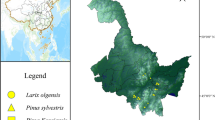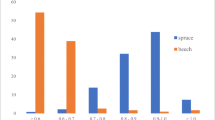Abstract
The main purpose of the present investigation is to examine and compare three methods for diameter distribution modeling in terms of their fitness to predict from stand level variables the diameter distributions of even-aged Austrian black pine (Pinus nigra Arn.) plantations in Bulgaria. The percentile-based projection method involving empirical probability density function based on 12 percentiles was the first method tested. A new modified approach based on the first method was proposed as the second alternative. The third method was the 2-parameter Weibull functional model in which parameters were recovered from the first and the second raw moments and the second central moment of the empirical distributions. The Kolmogorov–Smirnov test was applied to compare the experimental distributions with the predicted ones, and estimation of the error indices was employed to evaluate the total absolute deviation of the predicted numbers from the actual ones by diameter class. The two-parameter Weibull function proved superior to the examined alternative percentile-based projection methods and the newly proposed percentile method, without a driver percentile showed improved precision compared to the classical percentile method (with a driver percentile). The parameters of the Weibull frequency distribution function can be easily recovered from the stand quadratic mean diameter. Consequently, this diameter distribution model could be incorporated as a sub-model for stand horizontal structure characterization within the Stand Density Management Diagram modeling framework.


Similar content being viewed by others
References
Álvarez-González JG, Schröder J, Rodríguez Soalleiro R, Ruíz González AD (2002) Modelling the effect of thinnings on the diameter distribution of even-aged Maritime pine stands. For Eco Manag 165:57–65
Bailey RL, Dell TR (1973) Quantifying diamater distributions with the Weibull function. For Sci 19:97–104
Borders BE, Patterson WD (1990) Projecting stand tables: a comparison of the Weibull diameter distribution method, a percentile-based projection method, and a basal area growth projection method. For Sci 36:413–424
Borders BE, Souter RA, Bailey RL, Ware KD (1987) Percentile-based distributions characterize forest stand tables. For Sci 33:570–576
Bullock BP, Burkhart HE (2005) Juvenile diameter distributions of lonlolly pine characterized by the two-parameter Weibull function. New For 29:233–244. doi:10.1007/s11056-005-5651-5
Castedo-Dorado F, Diéguez-Aranda U, Barrio Anta M, Sánchez Rodríguez M, Von Gadow K (2006) A generalized height-diameter model including random components for radiata pine plantations in northwestern Spain. For Eco Manag 229:202–213. doi:10.1016/j.foreco.2006.04.028
Castedo-Dorado F, Diéguez-Aranda U, Álvarez-González JG (2007) A growth model for Pinus radiata D. Don. stands in north-western Spain. Ann For Sci 64:453–465. doi:10.1051/forest:2007023
Diéguez-Aranda U, Castedo-Dorado F, Álvarez-González JG, Rodríguez-Soalleiro R (2006) Dynamic growth model for Scots pine (Pinus sylvestris L.) plantations in Galicia (north-western Spain). Ecol Model 191:225–242. doi:10.1016/j.ecolmodel.2005.04.026
Dimitrov E (2003) Modeling of structure, volume and assortments of moderate-age and sub-mature dendrocoenoses of Scots Pine, Norway Spruce and Silver Fir. Simolini 94, Sofia (in Bulgarian)
Gregoire TG (1987) Generalized error structure for forestry yield models. For Sci 33:423–444
Hafley WL, Schreuder HT (1977) Statistical distributions for fitting diameter and height data in even-aged stands. Can J For Res 7:481–487
Little SN (1983) Weibull diameter distributions for mixed stands of western conifers. Can J For Res 13:85–88
Liu C, Zhang SY, Lei Y, Newton PF, Zhang L (2004) Evaluation of three methods for predicting diameter distributions of black spruce (Picea mariana) plantations in central Canada. Can J For Res 34:2424–2432. doi:10.1139/X04-117
Marinov IT (2006) Investigations on the surface water runoff and eroded soil from different areas in Ihtimanska Sredna gora Mountain. For Sci Sofia 2:77–85 (in Bulgarian)
Marinov IT, Mandev A, Grozeva M, Timousheva S, Markov I, Genov K (1997) Investigation on the hydrological effectiveness against erosion of the coniferous plantations in western Bulgaria. Report on the project with National forestry board. Forest Research Institute of BAS, Sofia (in Bulgarian)
Merganič J, Sterba H (2006) Characterization of diameter distribution using the Weibull function: method of moments. Eur J For Res 125:427–439. doi:10.1007/s10342-006-0138-2
Newton PF (2009) Development of an integrated decision-support model for density management within jack pine stand-types. Ecol Model 220:3301–3324
Newton PF, Lei Y, Zhang SY (2004) A parameter recovery model for estimating black spruce diameter distributions within the context of a stand density management diagram. For Chron 80(3):349–358
Newton PF, Lei Y, Zhang SY (2005) Stand-level diameter distribution yield model for black spruce plantations. For Eco Manag 209:181–192. doi:10.1016/j.foreco.2005.01.020
Porté A, Bartelink HH (2002) Modelling mixed forest growth: a review of models for forest management. Ecol Model 150:141–188
Pretzsch H, Biber P, Dursky J, Von Gadow K, Hasenauer H, Kandler G, Kenk G, Kublin E, Nagel J, Pukkala T, Skovgaard JP, Sodtke R, Sterba H (2006) Standardizing and categorizing tree growth models. In: Hasenauer H (ed) Sustainable forest management. Growth models in Europe. Springer, Berlin, Heidelberg, New York, pp 39–57
Rennolls K, Päivinen R, San-Miguel-Ayanz J, Tomé M, Skovsgaard JP, Palahi M, Matthews R (2009) Harmonization of European forest growing stocking data using a model-based conversion approach. For Biom Model Inform Sci 1:1–34
Reynolds MR, Burk TE, Huang W-C (1988) Goodness-of fit tests and model selection procedures for diameter distribution models. For Sci 34(2):373–399
Stankova T, Shibuya M (2007) Stand density control diagrams for Scots pine and Austrian black pine plantations in Bulgaria. New For 34(2):123–141. doi: 10.1007/s11056-007-9043-x
Stankova T, Zlatanov T (2007) Verification of a model of stand density control diagram for Austrian black pine plantations in Bulgaria. Silva Lusitana 15(2):171–188
Stankova T, Shibuya M, Hagihara A (2002) A method for density control of forest plantations. For Sci Sofia 2:27–38
Author information
Authors and Affiliations
Corresponding author
Additional information
Communicated by D. Mandallaz.
Rights and permissions
About this article
Cite this article
Stankova, T.V., Zlatanov, T.M. Modeling diameter distribution of Austrian black pine (Pinus nigra Arn.) plantations: a comparison of the Weibull frequency distribution function and percentile-based projection methods. Eur J Forest Res 129, 1169–1179 (2010). https://doi.org/10.1007/s10342-010-0407-y
Received:
Revised:
Accepted:
Published:
Issue Date:
DOI: https://doi.org/10.1007/s10342-010-0407-y




